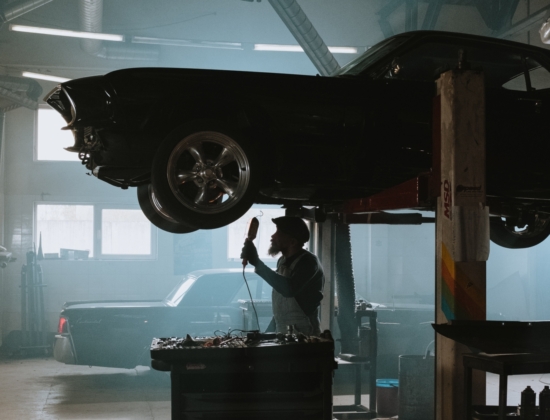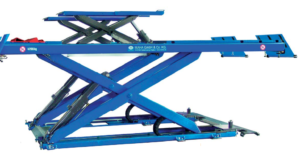Northern Ireland MOT crisis cost DVA £3.9 million, Lifts were run up to 8-times longer than designed
 Vehicle lifts are necessary for carrying out MOT tests because they are used to check under the body of most vehicles. While the image displayed shows a two-post lift, scissor lifts are deployed in all of the DVA test centres (Photo: Cottonbro; Pexels)
Vehicle lifts are necessary for carrying out MOT tests because they are used to check under the body of most vehicles. While the image displayed shows a two-post lift, scissor lifts are deployed in all of the DVA test centres (Photo: Cottonbro; Pexels)
When cracks were found in vehicle lifts belonging to Northern Ireland’s MOT body, Driver and Vehicle Agency (DVA), all of its 55 lifts and therefore the country’s centrally run MOT system came to a standstill. A little over a year later, the Northern Ireland Assembly’s Public Accounts Committee published its “Report on Driver and Vehicle Agency 2019-20”, which examined how vehicle testing came to be suspended due to problems with virtually all of the DVA’s vehicle lifts.
Now the report is out, we know the 2020 Northern Ireland MOT crisis not only brought the country’s vehicle testing regime to halt, it also cost the local a total of £3.9 million. But what caused the cracks? The Public Accounts Committee report cites an “independent engineers report” as concluding that the defects were a result of “fatigue and that the lifts had exceeded their design cycles”. That’s a bit of an understatement. 52 of the DVA’s 55 lifts were found to be defective. Just three of the total of 55 lifts were not found to be exhibiting signs of fatigue.
Why? The Committee heard that the 4.2 tonne Maha lifts in question were designed to undertake 22,000 lift cycles. However, DVA reports that its lifts were generally doing “approximately 20,000” lift cycles a year. And since the 55 lifts were installed in the period between 2011 and 2013, that means they had actually done between six and eight times the minimum figure they were designed to achieve. The Committee was a bit more conservative, estimating that each lift had done “approximately 150,000-160,000 lift cycles since installation”, which is probably based on the fact that the 55 lifts conducted a total of roughly 1 million MOTs a year prior to decommissioning. But even that figure will no-doubt have a degree of variation between locations. In any case, with no lift cycle counters installed on the 55 DVA machines, it is impossible to be precise. What is clear is that every DVA lift brought into service between 2011 and 2013 was significantly exceeding the usage it was designed for.
So, it is no surprise to learn that the failure to identify “an absolute life span for the lifts” was, in the Committee’s view, “a gross oversight”. Indeed, “discussions around life spans only started to occur in the aftermath of cracks
being found in lifts between November 2019 and January 2020.”
As a result, DVA’s Jeremy Logan reports that the “new lifts have all been installed with cycle counters”, something that was subsequently formalised into a recommendation by the public accounts committee. Indeed, in the committee’s view, the lack of data and an estimated “life span of essential equipment” was a “causal factor” in the suspension of MOT tests in January 2020.
A £12 million lift supply contact
Of course, scissor lifts are necessary for carrying out MOT tests because they are used to check under the body of most vehicles. The lifts within Northern Irish MOT centres are owned by the DVA and were supplied by Maha Ireland (Maha) between 2011 and 2013. “Since 2013 Maha have been contracted to supply and maintain the MOT vehicle testing equipment. Prior to this the DVA had a Private Finance Initiative (PFI) contract for the provision and maintenance of vehicle testing centres. The contract was in place with Romaha Limited since 2001. Romaha Limited was established solely to operate the PFI contract and comprised of two companies, one of which was Maha. As such there has been a long-standing relationship between the DVA
and Maha”, the public finance committee report explains.
However, the public finance committee report raised questions about the both the rigorousness and tender process associated with the Maha contract: “The Committee expressed concern that there has been no open competition for the contract to supply and maintain the current MOT vehicle testing equipment since Maha was awarded the contract in 2013.”
The length and cost of the contract came in for particular scrutiny: “The Committee heard that there have been a number of extensions to the contract and Maha will continue to provide the service to 2024”, concluding: “That is a period of 11 years at a cost of over £12 million.”
52 lifts replaced at a cost of £1.8 million
In February 2020 Maha Ireland confirmed that the Maha DUO+1 scissor lift was the garage equipment at the centre of the Northern Ireland MOT crisis (Photo: Maha Ireland)
In February 2020, Maha Ireland confirmed to Tyres & Accessories that lifts at the centre of the Northern Ireland MOT crisis were all the Maha DUO+1 model. Maha was responsible for maintaining the lifts and was also responsible for the inspection of those lifts via six-monthly “Thorough Examination Inspections”, which were subcontracted by Maha to HSB engineering insurance.
In the end, the DVA replaced 52 out of the 55 lifts it owns. According to the report, the replacement lifts were supplied by Maha following the receipt of legal and procurement advice, which stated: “”legal proceedings could be protracted, costly and would not guarantee a resolution. Given the impact of the disruption to services and the need to restore services as quickly as possible, the most cost-effective option, for the DVA, was to negotiate with the contractor for replacement of the lifts at a discounted price.”
The “discounted price” for 52 lifts was £1.8 million, which works out at £34,615 each. Since the replacement costs were outside the contract, this appears to be in addition to the £12 million Maha Ireland was contracted by DVA over a period of 11 years.
Bearing all this in mind, the Northern Irish public finance report recommended that “DVA strengthens its oversight of the contract with Maha particularly regarding the quality of the planned and preventative maintenance regime” and that “DVA should ensure that any
future relationships with new suppliers are underpinned by contracts which include strong performance and penalty clauses.
Nevertheless, despite the early 2020 MOT crisis, which was followed by further lost fee income lost due to the impact of Covid 19, DVA used cash reserves to balance its books: “Witnesses told the Committee that the loss
of income and costs associated with the lift failures were financed by the DVA and
were completely separate from the funding now secured to compensate for the
loss of income arising from the impact of Covid 19.”
From and English point of view, the whole debacle, relayed to us all in technicolour thanks to the public finance committee investigation illustrates two clear points. Regarding the equipment itself, professional garage lifting technology works best with the right kind of scheduled maintenance; and cannot be isolated from its workload. And regarding the centralised Northern Ireland MOT philosophy, it appears to be a clear example of why a free-market approach might be better.





Comments